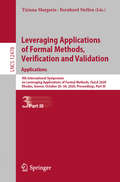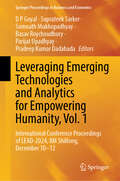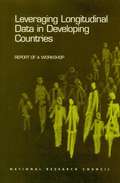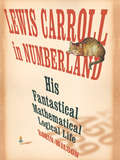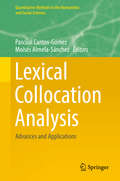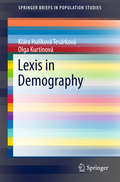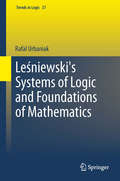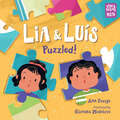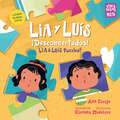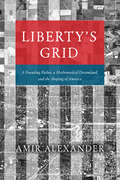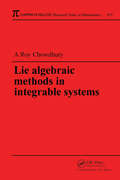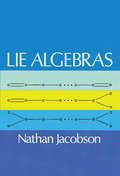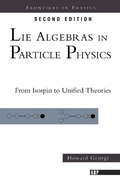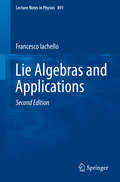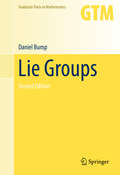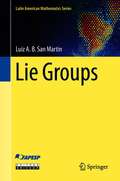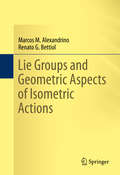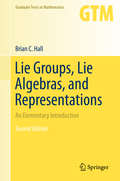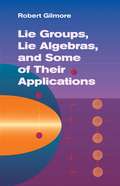- Table View
- List View
Leveraging Applications of Formal Methods, Verification and Validation: 9th International Symposium on Leveraging Applications of Formal Methods, ISoLA 2020, Rhodes, Greece, October 20–30, 2020, Proceedings, Part III (Lecture Notes in Computer Science #12478)
by Tiziana Margaria Bernhard SteffenThe three-volume set LNCS 12476 - 12478 constitutes the refereed proceedings of the 9th International Symposium on Leveraging Applications of Formal Methods, ISoLA 2020, which was planned to take place during October 20–30, 2020, on Rhodes, Greece. The event itself was postponed to 2021 due to the COVID-19 pandemic. The papers presented were carefully reviewed and selected for inclusion in the proceedings. Each volume focusses on an individual topic with topical section headings within the volume:Part I, Verification Principles: Modularity and (De-)Composition in Verification; X-by-Construction: Correctness meets Probability; 30 Years of Statistical Model Checking; Verification and Validation of Concurrent and Distributed Systems. Part II, Engineering Principles: Automating Software Re-Engineering; Rigorous Engineering of Collective Adaptive Systems. Part III, Applications: Reliable Smart Contracts: State-of-the-art, Applications, Challenges and Future Directions; Automated Verification of Embedded Control Software; Formal methods for DIStributed COmputing in future RAILway systems.
Leveraging Emerging Technologies and Analytics for Empowering Humanity, Vol. 1: International Conference Proceedings of LEAD-2024, IIM Shillong, December 10–12 (Springer Proceedings in Business and Economics)
by Somnath Mukhopadhyay Suprateek Sarker D P Goyal Basav Roychoudhury Parijat Upadhyay Pradeep Kumar DadabadaThis book provides a platform for interdisciplinary discussions on leveraging emerging technologies and analytics to empower humanity, fostering collaboration between experts in AI and analytics, sustainability, different areas of management, and IT. As the world grapples with complex challenges, from climate change to economic inequality, this first volume of a two-volume proceedings series is a crucial resource for fostering collaboration and exploring untapped potential of emerging technologies. By harnessing the power of AI, blockchain, IoT, and big data, the chapters address critical global challenges towards improving quality of life and promoting inclusive and sustainable development, while keeping in mind ethical implications, and their impact on social justice. The volume will be of use to thought leaders, researchers, innovators, and policymakers from around the globe who are interested in knowing more on how cutting-edge technologies can be harnessed for the greater good of society.
Leveraging Longitudinal Data in Developing Countries: Report of a Workshop
by Workshop on Leveraging Longitudinal Data in Developing Countries CommitteeA report on Leveraging Longitudinal Data in Developing Countries
Lewis Carroll in Numberland: His Fantastical Mathematical Logical Life
by Robin Wilson"A fine mathematical biography."--John Allen Paulos, New York Times Book Review Just when we thought we knew everything about Lewis Carroll, here comes this "insightful . . . scholarly . . . serious" (John Butcher, American Scientist) biography that will appeal to Alice fans everywhere. Fascinated by the inner life of Charles Lutwidge Dodgson, Robin Wilson, a Carroll scholar and a noted mathematics professor, has produced this revelatory book--filled with more than one hundred striking and often playful illustrations--that examines the many inspirations and sources for Carroll's fantastical writings, mathematical and otherwise. As Wilson demonstrates, Carroll made significant contributions to subjects as varied as voting patterns and the design of tennis tournaments, in the process creating large numbers of imaginative recreational puzzles based on mathematical ideas.
Lexi Magill and the Teleportation Tournament
by Kim LongFor fans of The Amazing Race, Lexi Magill and the Teleportation Tournament is the perfect adventure for middle grade readers who like scavenger hunts and puzzle-solving.Twelve-year-old physics whiz Lexi Magill won't let anything stop her from winning Wisconsin's Teleportation Tournament--the annual competition where teams teleport around the world to solve science-based puzzles. She needs the prize money if she wants to re-enroll in the science academy her parents can no longer afford. Added bonus: she'll be able to reconnect with her best friend Haley.But Lexi's two teammates put a wrench in her plans. When one misreads a clue that lands the team in a castle in Germany, and the other loses her teleportation medallion in Poland, Lexi wonders what she's gotten herself into. Struggling to keep her team under control as the race rages on, Lexi not only has to figure out how to get back on course (literally), but she must decide how far she's willing to go to win, and who her real friends are. With riddles to solve and messages to decode, this interactive read won't disappoint!
Lexical Collocation Analysis: Advances and Applications (Quantitative Methods in the Humanities and Social Sciences)
by Pascual Cantos-Gómez Moisés Almela-SánchezThis book re-examines the notion of word associations, more precisely collocations. It attempts to come to a potentially more generally applicable definition of collocation and how to best extract, identify and measure collocations. The book highlights the role played by (i) automatic linguistic annotation (part-of-speech tagging, syntactic parsing, etc.), (ii) using semantic criteria to facilitate the identification of collocations, (iii) multi-word structured, instead of the widespread assumption of bipartite collocational structures, for capturing the intricacies of the phenomenon of syntagmatic attraction, (iv) considering collocation and valency as near neighbours in the lexis-grammar continuum and (v) the mathematical properties of statistical association measures in the automatic extraction of collocations from corpora. This book is an ideal guide to the use of statistics in collocation analysis and lexicography, as well as a practical text to the development of skills in the application of computational lexicography. Lexical Collocation Analysis: Advances and Applications begins with a proposal for integrating both collocational and valency phenomena within the overarching theoretical framework of construction grammar. Next the book makes the case for integrating advances in syntactic parsing and in collocational analysis. Chapter 3 offers an innovative look at complementing corpus data and dictionaries in the identification of specific types of collocations consisting of restricted predicate-argument combinations. This strategy complements corpus collocational data with network analysis techniques applied to dictionary entries. Chapter 4 explains the potential of collocational graphs and networks both as a visualization tool and as an analytical technique. Chapter 5 introduces MERGE (Multi-word Expressions from the Recursive Grouping of Elements), a data-driven approach to the identification and extraction of multi-word expressions from corpora. Finally the book concludes with an analysis and evaluation of factors influencing the performance of collocation extraction methods in parsed corpora.
Lexis in Demography
by Klára Hulíková Tesárková Olga KurtinováThis book explores the life of economist and social scientist Wilhelm Lexis and the key demographic instrument named after him: the Lexis diagram. It describes this vital tool, which helps demographers visualize data, and examines its various forms through a specially designed example. As a result, readers get to see the Lexis diagram in practice and gain first-hand insight into its different forms.The authors first present a brief description of the life of W. Lexis with information about his childhood, studies, and work. Coverage details the places closely related to him as well as his working positions. It also lists and characterizes his publications.The book then goes on to summarize and describe the chronological development of the Lexis diagram, from initial developments through the specific contributions of W. Lexis to the refinements of those who followed. Throughout, it clearly describes as well as graphically and practically illustrates all the different versions of the diagram covered.Next, readers are presented with contemporary practical applications, including: Statistical Analysis System (SAS), R, and Stata software as well as selected key-studies from demographic, epidemiologic, and migration research.The Lexis diagram is an essential tool for working correctly with demographic data. This book commemorates the man who helped to develop these diagrams and his unquestionable influence on demography. It also provides readers with deep knowledge and insights into this basic, yet important, tool.
Leśniewski's Systems of Logic and Foundations of Mathematics
by Rafal UrbaniakThis meticulous critical assessment of the ground-breaking work of philosopher Stanislaw Leśniewski focuses exclusively on primary texts and explores the full range of output by one of the master logicians of the Lvov-Warsaw school. The author's nuanced survey eschews secondary commentary, analyzing Leśniewski's core philosophical views and evaluating the formulations that were to have such a profound influence on the evolution of mathematical logic. One of the undisputed leaders of the cohort of brilliant logicians that congregated in Poland in the early twentieth century, Leśniewski was a guide and mentor to a generation of celebrated analytical philosophers (Alfred Tarski was his PhD student). His primary achievement was a system of foundational mathematical logic intended as an alternative to the Principia Mathematica of Alfred North Whitehead and Bertrand Russell. Its three strands--'protothetic', 'ontology', and 'mereology', are detailed in discrete sections of this volume, alongside a wealth other chapters grouped to provide the fullest possible coverage of Leśniewski's academic output. With material on his early philosophical views, his contributions to set theory and his work on nominalism and higher-order quantification, this book offers a uniquely expansive critical commentary on one of analytical philosophy's great pioneers.
Lia & Luis: Puzzled! (Storytelling Math)
by Ana CrespoCelebrate diversity, math, and the power of storytelling!Twins Lia and Luís have received a secret puzzle from their grandma! Can they put it together to read the hidden message? A playful exploration of geometry and sorting featuring Brazilian American characters and a glossary of Brazilian Portuguese words.Storytelling Math celebrates children using math in their daily adventures as they play, build, and discover the world around them. Joyful stories and hands-on activities make it easy for kids and their grown-ups to explore everyday math together. Developed in collaboration with math experts at STEM education nonprofit TERC, under a grant from the Heising-Simons Foundation.
Lia y Luís: ¡Desconcertados! / Lia & Luís: Puzzled! (Storytelling Math)
by Ana Crespo¡Celebra la diversidad, las matemáticas y el poder de contar historias con esta edición bilingüe (español e inglés)!Celebrate diversity, math, and the power of storytelling with this bilingual (Spanish and English) edition!Los mellizos Lia y Luís han recibido de su abuela un rompecabezas con un código secreto. ¿Podrán armarlo para leer el mensaje oculto? Una divertida exploración de la geometría y la clasificación con personajes brasileño-estadounidenses y un glosario de palabras de portugués brasileño.Los libros de la serie Cuentos matemáticos celebran que los niños usen las matemáticas en sus aventuras diarias mientras juegan, construyen y descubren el mundo que los rodea. Historias divertidas y actividades prácticas facilitan que los niños y los adultos exploren juntos las matemáticas de la vida diaria. Han sido desarrolladas en colaboración con expertos en matemáticas para las áreas de ciencia, tecnología, ingeniería y matemáticas de la organización sin fines de lucro TERC, con una beca de la Heising-Simons Foundation.Twins Lia and Luís have received a secret puzzle from their grandma! Can they put it together to read the hidden message? A playful exploration of geometry and sorting featuring Brazilian American characters and a glossary of Brazilian Portuguese words.Storytelling Math celebrates children using math in their daily adventures as they play, build, and discover the world around them. Joyful stories and hands-on activities make it easy for kids and their grown-ups to explore everyday math together. Developed in collaboration with math experts at STEM education nonprofit TERC, under a grant from the Heising-Simons Foundation.
Liberalization, Growth and Regional Disparities in India
by Madhusudan GhoshUpon the backdrop of impressive progress made by the Indian economy during the last two decades after the large-scale economic reforms in the early 1990s, this book evaluates the performance of the economy on some income and non-income dimensions of development at the national, state and sectoral levels. It examines regional economic growth and inequality in income originating from agriculture, industry and services. In view of the importance of the agricultural sector, despite its declining share in gross domestic product, it evaluates the performance of agricultural production and the impact of agricultural reforms on spatial integration of food grain markets. It studies rural poverty, analyzing the trend in employment, the trickle-down process and the inclusiveness of growth in rural India. It also evaluates the impact of microfinance, as an instrument of financial inclusion, on the socio-economic conditions of rural households. Lastly, it examines the relative performance of fifteen major states of India in terms of education, health and human development. An important feature of the book is that it approaches these issues, applying rigorously advanced econometric methods, and focusing primarily on their regional disparities during the post-reform period vis-à-vis the pre-reform period. It offers important results to guide policies for future development.
Liberty's Grid: A Founding Father, a Mathematical Dreamland, and the Shaping of America
by Amir AlexanderThe surprising history behind a ubiquitous facet of the United States: the gridded landscape. Seen from an airplane, much of the United States appears to be a gridded land of startling uniformity. Perpendicular streets and rectangular fields, all precisely measured and perfectly aligned, turn both urban and rural America into a checkerboard landscape that stretches from horizon to horizon. In evidence throughout the country, but especially the West, the pattern is a hallmark of American life. One might consider it an administrative convenience—an easy way to divide land and lay down streets—but it is not. The colossal grid carved into the North American continent, argues historian and writer Amir Alexander, is a plan redolent with philosophical and political meaning. In 1784 Thomas Jefferson presented Congress with an audacious scheme to reshape the territory of the young United States. All western lands, he proposed, would be inscribed with a single rectilinear grid, transforming the natural landscape into a mathematical one. Following Isaac Newton and John Locke, he viewed mathematical space as a blank slate on which anything is possible and where new Americans, acting freely, could find liberty. And if the real America, with its diverse landscapes and rich human history, did not match his vision, then it must be made to match it. From the halls of Congress to the open prairies, and from the fight against George III to the Trail of Tears, Liberty’s Grid tells the story of the battle between grid makers and their opponents. When Congress endorsed Jefferson’s plan, it set off a struggle over American space that has not subsided. Transcendentalists, urban reformers, and conservationists saw the grid not as a place of possibility but as an artificial imposition that crushed the human spirit. Today, the ideas Jefferson associated with the grid still echo through political rhetoric about the country’s founding, and competing visions for the nation are visible from Manhattan avenues and Kansan pastures to Yosemite’s cliffs and suburbia’s cul-de-sacs. An engrossing read, Liberty’s Grid offers a powerful look at the ideological conflict written on the landscape.
Lie Algebraic Methods in Integrable Systems (Chapman And Hall/crc Research Notes In Mathematics Ser. #Vol. 415)
by Amit K. Roy-ChowdhuryOver the last thirty years, the subject of nonlinear integrable systems has grown into a full-fledged research topic. In the last decade, Lie algebraic methods have grown in importance to various fields of theoretical research and worked to establish close relations between apparently unrelated systems. The various ideas associated with Lie algebra and Lie groups can be used to form a particularly elegant approach to the properties of nonlinear systems. In this volume, the author exposes the basic techniques of using Lie algebraic concepts to explore the domain of nonlinear integrable systems. His emphasis is not on developing a rigorous mathematical basis, but on using Lie algebraic methods as an effective tool.The book begins by establishing a practical basis in Lie algebra, including discussions of structure Lie, loop, and Virasor groups, quantum tori and Kac-Moody algebras, and gradation. It then offers a detailed discussion of prolongation structure and its representation theory, the orbit approach-for both finite and infinite dimension Lie algebra. The author also presents the modern approach to symmetries of integrable systems, including important new ideas in symmetry analysis, such as gauge transformations, and the "soldering" approach. He then moves to Hamiltonian structure, where he presents the Drinfeld-Sokolov approach, the Lie algebraic approach, Kupershmidt's approach, Hamiltonian reductions and the Gelfand Dikii formula. He concludes his treatment of Lie algebraic methods with a discussion of the classical r-matrix, its use, and its relations to double Lie algebra and the KP equation.
Lie Algebras (Dover Books on Mathematics)
by Nathan JacobsonLie group theory, developed by M. Sophus Lie in the 19th century, ranks among the more important developments in modern mathematics. Lie algebras comprise a significant part of Lie group theory and are being actively studied today. This book, by Professor Nathan Jacobson of Yale, is the definitive treatment of the subject and can be used as a textbook for graduate courses.Chapter I introduces basic concepts that are necessary for an understanding of structure theory, while the following three chapters present the theory itself: solvable and nilpotent Lie algebras, Carlan's criterion and its consequences, and split semi-simple Lie algebras. Chapter 5, on universal enveloping algebras, provides the abstract concepts underlying representation theory. Then the basic results on representation theory are given in three succeeding chapters: the theorem of Ado-Iwasawa, classification of irreducible modules, and characters of the irreducible modules. In Chapter 9 the automorphisms of semi-simple Lie algebras over an algebraically closed field of characteristic zero are determined. These results are applied in Chapter 10 to the problems of sorting out the simple Lie algebras over an arbitrary field. The reader, to fully benefit from this tenth chapter, should have some knowledge about the notions of Galois theory and some of the results of the Wedderburn structure theory of associative algebras.Nathan Jacobson, presently Henry Ford II Professor of Mathematics at Yale University, is a well-known authority in the field of abstract algebra. His book, Lie Algebras, is a classic handbook both for researchers and students. Though it presupposes a knowledge of linear algebra, it is not overly theoretical and can be readily used for self-study.
Lie Algebras In Particle Physics
by Howard GeorgiGeorgi's Harvard lectures (he's taught physics there since 1980) discuss application of the theory of Lie Algebras and their representations to a wide variety of problems in particles physics and quantum mechanics. This edition has been expanded to include more extensive discussion of finite group theory and representations of the permutation group, as well as discussion of new subjects such as Dynkin indices, spontaneous symmetry breaking, lepton number as a fourth color, and the 27-dimensional representation of E(6). Annotation c. Book News, Inc. , Portland, OR (booknews. com)
Lie Algebras In Particle Physics
by Howard GeorgiHoward Georgi is the co-inventor (with Sheldon Glashow) of the SU(5) theory. This extensively revised and updated edition of his classic text makes the theory of Lie groups accessible to graduate students, while offering a perspective on the way in which knowledge of such groups can provide an insight into the development of unified theories of strong, weak, and electromagnetic interactions.
Lie Algebras In Particle Physics
by Howard GeorgiHoward Georgi is the co-inventor (with Sheldon Glashow) of the SU(5) theory. This extensively revised and updated edition of his classic text makes the theory of Lie groups accessible to graduate students, while offering a perspective on the way in which knowledge of such groups can provide an insight into the development of unified theories of strong, weak, and electromagnetic interactions.
Lie Algebras In Particle Physics
by Howard GeorgiHoward Georgi is the co-inventor (with Sheldon Glashow) of the SU(5) theory. This extensively revised and updated edition of his classic text makes the theory of Lie groups accessible to graduate students, while offering a perspective on the way in which knowledge of such groups can provide an insight into the development of unified theories of strong, weak, and electromagnetic interactions.
Lie Algebras and Applications
by Francesco IachelloThis course-based primer provides an introduction to Lie algebras and some of their applications to the spectroscopy of molecules, atoms, nuclei and hadrons. In the first part, it concisely presents the basic concepts of Lie algebras, their representations and their invariants. The second part includes a description of how Lie algebras are used in practice in the treatment of bosonic and fermionic systems. Physical applications considered include rotations and vibrations of molecules (vibron model), collective modes in nuclei (interacting boson model), the atomic shell model, the nuclear shell model, and the quark model of hadrons. One of the key concepts in the application of Lie algebraic methods in physics, that of spectrum generating algebras and their associated dynamic symmetries, is also discussed. The book highlights a number of examples that help to illustrate the abstract algebraic definitions and includes a summary of many formulas of practical interest, such as the eigenvalues of Casimir operators, and the dimensions of the representations of all classical Lie algebras. For this new edition, the text has been carefully revised and expanded; in particular, a new chapter has been added on the deformation and contraction of Lie algebras. From the reviews of the first edition: "Iachello has written a pedagogical and straightforward presentation of Lie algebras [. . . ]. It is a great text to accompany a course on Lie algebras and their physical applications. " (Marc de Montigny, Mathematical Reviews, Issue, 2007 i) "This book [. . . ] written by one of the leading experts in the field [. . . ] will certainly be of great use for students or specialists that want to refresh their knowledge on Lie algebras applied to physics. [. . . ] An excellent reference for those interested in acquiring practical experience [. . . ] and leaving the embarrassing theoretical presentations aside. " (Rutwig Campoamor-Stursberg, Zentralblatt MATH, Vol. 1156, 2009)
Lie Groups
by Daniel BumpThis book is intended for a one-year graduate course on Lie groups and Lie algebras. The book goes beyond the representation theory of compact Lie groups, which is the basis of many texts, and provides a carefully chosen range of material to give the student the bigger picture. The book is organized to allow different paths through the material depending on one's interests This second edition has substantial new material, including improved discussions of underlying principles, streamlining of some proofs, and many results and topics that were not in the first edition. For compact Lie groups, the book covers the Peter-Weyl theorem, Lie algebra, conjugacy of maximal tori, the Weyl group, roots and weights, Weyl character formula, the fundamental group and more. The book continues with the study of complex analytic groups and general noncompact Lie groups, covering the Bruhat decomposition, Coxeter groups, flag varieties, symmetric spaces, Satake diagrams, embeddings of Lie groups and spin. Other topics that are treated are symmetric function theory, the representation theory of the symmetric group, Frobenius-Schur duality and GL(n) × GL(m) duality with many applications including some in random matrix theory, branching rules, Toeplitz determinants, combinatorics of tableaux, Gelfand pairs, Hecke algebras, the "philosophy of cusp forms" and the cohomology of Grassmannians. An appendix introduces the reader to the use of Sage mathematical software for Lie group computations.
Lie Groups (Latin American Mathematics Series)
by Luiz A. San MartinThis textbook provides an essential introduction to Lie groups, presenting the theory from its fundamental principles. Lie groups are a special class of groups that are studied using differential and integral calculus methods. As a mathematical structure, a Lie group combines the algebraic group structure and the differentiable variety structure. Studies of such groups began around 1870 as groups of symmetries of differential equations and the various geometries that had emerged. Since that time, there have been major advances in Lie theory, with ramifications for diverse areas of mathematics and its applications.Each chapter of the book begins with a general, straightforward introduction to the concepts covered; then the formal definitions are presented; and end-of-chapter exercises help to check and reinforce comprehension. Graduate and advanced undergraduate students alike will find in this book a solid yet approachable guide that will help them continue their studies with confidence.
Lie Groups and Geometric Aspects of Isometric Actions
by Marcos M. Alexandrino Renato G. BettiolThis book provides quick access to the theory of Lie groups and isometric actions on smooth manifolds, using a concise geometric approach. After a gentle introduction to the subject, some of its recent applications to active research areas are explored, keeping a constant connection with the basic material. The topics discussed include polar actions, singular Riemannian foliations, cohomogeneity one actions, and positively curved manifolds with many symmetries. This book stems from the experience gathered by the authors in several lectures along the years and was designed to be as self-contained as possible. It is intended for advanced undergraduates, graduate students and young researchers in geometry and can be used for a one-semester course or independent study.
Lie Groups, Lie Algebras, and Representations
by Brian C. HallThis textbook treats Lie groups, Lie algebras and their representations in an elementary but fully rigorous fashion requiring minimal prerequisites. In particular, the theory of matrix Lie groups and their Lie algebras is developed using only linear algebra, and more motivation and intuition for proofs is provided than in most classic texts on the subject. In addition to its accessible treatment of the basic theory of Lie groups and Lie algebras, the book is also noteworthy for including: a treatment of the Baker-Campbell-Hausdorff formula and its use in place of the Frobenius theorem to establish deeper results about the relationship between Lie groups and Lie algebras motivation for the machinery of roots, weights and the Weyl group via a concrete and detailed exposition of the representation theory of sl(3;C) an unconventional definition of semisimplicity that allows for a rapid development of the structure theory of semisimple Lie algebras a self-contained construction of the representations of compact groups, independent of Lie-algebraic arguments The second edition of Lie Groups, Lie Algebras, and Representations contains many substantial improvements and additions, among them: an entirely new part devoted to the structure and representation theory of compact Lie groups; a complete derivation of the main properties of root systems; the construction of finite-dimensional representations of semisimple Lie algebras has been elaborated; a treatment of universal enveloping algebras, including a proof of the Poincar#65533;-Birkhoff-Witt theorem and the existence of Verma modules; complete proofs of the Weyl character formula, the Weyl dimension formula and the Kostant multiplicity formula. Review of the first edition: This is an excellent book. It deserves to, and undoubtedly will, become the standard text for early graduate courses in Lie group theory . . . an important addition to the textbook literature . . . it is highly recommended. -- The Mathematical Gazette
Lie Groups, Lie Algebras, and Representations: An Elementary Introduction (Graduate Texts in Mathematics #222)
by Brian HallThis textbook treats Lie groups, Lie algebras and their representations in an elementary but fully rigorous fashion requiring minimal prerequisites. In particular, the theory of matrix Lie groups and their Lie algebras is developed using only linear algebra, and more motivation and intuition for proofs is provided than in most classic texts on the subject.In addition to its accessible treatment of the basic theory of Lie groups and Lie algebras, the book is also noteworthy for including:a treatment of the Baker–Campbell–Hausdorff formula and its use in place of the Frobenius theorem to establish deeper results about the relationship between Lie groups and Lie algebrasmotivation for the machinery of roots, weights and the Weyl group via a concrete and detailed exposition of the representation theory of sl(3;C)an unconventional definition of semisimplicity that allows for a rapid development of the structure theory of semisimple Lie algebrasa self-contained construction of the representations of compact groups, independent of Lie-algebraic argumentsThe second edition of Lie Groups, Lie Algebras, and Representations contains many substantial improvements and additions, among them: an entirely new part devoted to the structure and representation theory of compact Lie groups; a complete derivation of the main properties of root systems; the construction of finite-dimensional representations of semisimple Lie algebras has been elaborated; a treatment of universal enveloping algebras, including a proof of the Poincaré–Birkhoff–Witt theorem and the existence of Verma modules; complete proofs of the Weyl character formula, the Weyl dimension formula and the Kostant multiplicity formula.Review of the first edition:This is an excellent book. It deserves to, and undoubtedly will, become the standard text for early graduate courses in Lie group theory ... an important addition to the textbook literature ... it is highly recommended.— The Mathematical Gazette
Lie Groups, Lie Algebras, and Some of Their Applications (Dover Books on Mathematics)
by Robert GilmoreLie group theory plays an increasingly important role in modern physical theories. Many of its calculations remain fundamentally unchanged from one field of physics to another, altering only in terms of symbols and the language. Using the theory of Lie groups as a unifying vehicle, concepts and results from several fields of physics can be expressed in an extremely economical way. With rigor and clarity, this text introduces upper-level undergraduate students to Lie group theory and its physical applications.An opening discussion of introductory concepts leads to explorations of the classical groups, continuous groups and Lie groups, and Lie groups and Lie algebras. Some simple but illuminating examples are followed by examinations of classical algebras, Lie algebras and root spaces, root spaces and Dynkin diagrams, real forms, and contractions and expansions. Reinforced by numerous exercises, solved problems, and figures, the text concludes with a bibliography and indexes.
